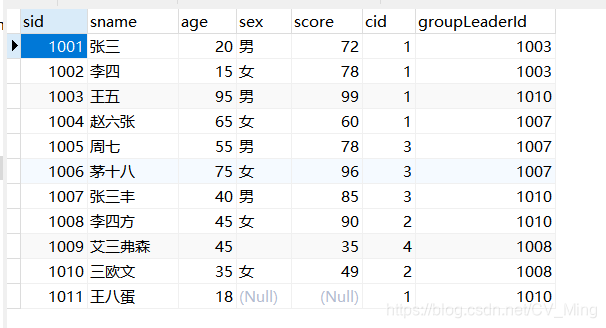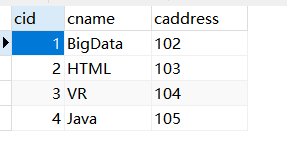mysql database, a complete set of commonly used query statements
The following records commonly used SQL DQL statements; basic query, conditional query, fuzzy query, sort query, aggregate function, de-duplication, paging query, limited output, multi-table query...
基本语法:
增:
添加数据:inset into 表名 (列名1,列名2,...)values(值1,值2,...)
添加列:alter table 表名 add 列名 数据类型(长度);
删:delete from 表名
删除列:alter table 表名 drop 列名
可根据需要加上条件,否则删除全表
改:update 表名 set 字段1=值,字段2=值 ...
可根据需要加上条件,否则更新全表
更新列名:alter table 表名 change 旧列名 新列名 数据类型(长度)
查:select 查询列名(多个列名用,隔开)from 表名
1. Basic query
Syntax: select query column name (used for multiple column names, separated) from table name
*PS: query all columns can be used *instead of all column names, *the time complexity is high, when writing a project to list all the need to query Column
Example:
-Query specified column
-Query student ID, name, age

Two-condition query
-
understanding
-
The conditional query is to use the
where statement after the basic query during the query , and use the operator after the where to retain the eligible data
Condition symbol
- = Equal
- != <> varies
- <less than> greater than <= less than or equal>= greater than or equal
-
and and/and
-----------the conditions on both sides are satisfied at the same time -
or or
------------- One of the conditions on both sides is satisfied - in(set) range is within the range of set collection
-
between value 1 and value 2
------------ between value 1 and value 2 (including critical value, from small to large) -
not in inverted
example:
- Query student records of students aged between 20-40

- records check student number is not 1, 2

Three fuzzy queries
Fuzzy query needs to be placed after where and use like keyword
: wildcard:
%, can match any number of any characters
_, can match any character
例·:-- 查询姓名以“张”开头的学生记录
select * from stu where sname like '张%';
-- 查询姓名中包含“三”的学生记录
select * from stu where sname like '%三%'
Four sorting query
Sort the queried results in a certain order
order by field [desc|asc] ==> desc descending order, asc ascending order
例:
-- 不写排序类型,默认是升序
select * from stu order by age
-- 查询所有学生记录,按年龄升序排序,如果年龄相同时,按编号降序排序
select * from stu order by age asc,sid desc
Five aggregate functions
Aggregate function:
count(column name) counts the number of rows where the specified column is not null.
max(column name) obtains the maximum value in the specified column. If it is a string,
min(column name) obtains the minimum
sum (column name) in character order Specify the sum value of the column, calculate the non-number, the result is 0
avg (column name) Calculate the average value of the specified column, calculate the non-number, the result is 0
Syntax:
select aggregate function from table name [where…]
-- 查询最高成绩和最低成绩:
select max(score) '最高分',min(score) '最低分' from stu;
-- 统计stu表中成绩大于60的最高成绩和最低成绩:
select max(score) '最高分',min(score) '最低分' from stu where score > 60;
ps:
The column name that appears with the aggregate function must appear after the group by.
On the contrary, if there is a field that does not appear after the groupby, the query result is abnormal!
Six deduplication
The deduplication function distinct (column)
deduplicates the data in the specified column
Syntax:
selectdistinct (column name) from table name [where …]
-- 不重复的年龄
select distinct(age) from stu;
-- 查询年龄不重复的共有多少人
select count(distinct age) from stu;
Seven group query
When you need to query by group, you need to use the group by statement.
Syntax:
select * from stu [where …] group by field [order by…]
Groups with the same field value are grouped.
Note:
1 Generally, the operations after grouping are aggregation operations.
2 Divide into several groups, and the result of the virtual table is a few rows of data.
3 Aggregate functions are to perform separate aggregation operations for each group.
Filter after grouping, you need to use the having clause
The difference between hacing and where:
where is the filtering before grouping, and having is the filtering
after grouping. Aggregate functions cannot be used after where, but aggregate functions can be used for having.
Example:
-- 查询男生多少人,女生多少人
select sex,count(*) '人数' from stu group by sex;
-- 查询每个班级的班级编号和每个班级的成绩和:
select cid,sum(score) from stu group by cid;
-- 查询每个班级的班级编号以及每个班级的人数:
select cid '班级',count(sid) '人数' from stu group by cid;
-- 查询成绩总和大于200的班级编号以及成绩和
select cid,sum(score) from stu group by cid having sum(score) > 200
-- having可以使用前面定义的别名
select cid,sum(score) 'sum' from stu group by cid having sum > 200
-- 查询成绩总和大于200的班级编号以及成绩和并根据成绩总和降序
select cid,sum(score) 'sum' from stu group by cid having sum > 200 order by sum asc;
Eight limit output
You can limit the output of the query results.
You can limit the number of output and where to output.
Syntax:
write limit offset at the end of the sql statement, row_count
limit start subscript, number of rows;
for example: limit 0,2; ==> output from the first line, output 2 lines
Example:
-- 输出前两条
select * from stu limit 0,2;
-- 从第四条开始,输出三条
select * from stu limit 3,3;
Nine functions
Process function
If(expr1,expr2,expr3)
If expr1 is true, return expr2, otherwise return expr3
– isnull() function, judge whether it is empty
– isnull(field) If it is null, return 1 if it is not null return 0
Example:
-- 查询学生id,姓名,成绩,如果成绩为null,显示缺考
select sid,sname,if(isnull(score)=1,'缺考',score) from stu;
CASE WHEN [expr1] THEN [result1]… ELSE [default] END If expr is true, return result1, otherwise return to default
case
when condition then execute statement
when condition then execute statement
…
else execute statement
end
execute the condition after the first when , If it is true, execute the statement after then,
if the condition after when is false, execute the condition after the second when
If it is all false, execute the statement after else
Example:
-- 查询学生id,姓名,成绩,以及等级
-- (0-59 不及格,60-69中,70-89良,90-100优 )
select sid,sname,score,
case
when score < 60 then '不及格'
when score < 70 then '中'
when score < 90 then '良'
when isnull(score)=1 then '缺考'
else '优'
end as '等级'
from stu
More than ten table queries
** Union query-combined result set **
The query results of the two tables are spliced together vertically . The number, type and order of the fields of the two tables joined by
union / union all
are guaranteed to be the same.
Union will de- duplicate when splicing,
union all will splice all the data of the two tables
E.g:
select sid,sname from stu
union all
select cid,cname from class;
Connect query:
There are three types of relationships between tables: one-to-one, one-to
- many, and many -to -many. One -to- one relationship: you can add related fields to any table. One
-to-many relationship: you can only add related fields at the many end.
Many-to-many relationship: need to create a new table, use a third party to represent the relationship
Join query is to multiply multiple tables and multiple rows of data. It will also produce a Cartesian product
Internal connection:
Inner join syntax:
select * from Table 1 inner join Table 2 on Association conditions
Inner join will only retain data that fully meets the association conditions
Example:
-- 查询学生名称、学生成绩、班级名称、班级地址
select sname,score,cname,caddress from stu inner join class on stu.cid = class.cid
-- 内连接可以简写
select * from stu inner join class on stu.cid = class.cid
-- 简写成
select * from stu,class where stu.cid = class.cid
Outer join
Outer join: Will retain data that does not meet the conditions.
Left outer join-left outer join on
will retain the data that does not meet the conditions in the left table.
Right outer join-right outer join on
will retain the data that does not meet the conditions in the right table.
General outer Keywords can be omitted
Example:
-- 查询全部学生信息,如果有班级信息,一并查出.
select * from stu s left outer join class c on s.cid = c.cid
-- 查询全部班级信息,如果有学生,将学生信息查出
select * from stu s right outer join class c on s.cid = c.cid
Subquery
A subquery is a nested query.
Generally, a subquery appears after:
from, and after using
where as a table , it is used as a condition
Example:
-- 查询与张三同一个班级的学生。
-- 1查出张三的班级
select cid from stu where sname = '张三'
-- 2查出1班的学生
select * from stu where cid = 1
-- 合并成子查询
select * from stu where cid = (select cid from stu where sname = '张三')
-- 成绩高于3号班级所有人的学生信息
-- 1 找到3班最高分
select max(score) from stu where cid = 3
-- 2 找成绩比96高的学生
select * from stu where score > 96
-- 合并
select * from stu where score > (select max(score) from stu where cid = 3)
Self-connection
Self-connection is to connect itself, one table is used as two tables
s1 is the student table and s2 is the leader table
-the leader of s1 is the student in s2
select s1.sid, s1.sname, s2.sid, s2.sname from stu s1, stu s2 where s1.groupLeaderId = s2.sid and s1.sid = 1008
Example table:
create a student table:
DROP TABLE IF EXISTS `stu`;
CREATE TABLE `stu` (
`sid` int(11) DEFAULT NULL,
`sname` varchar(25) DEFAULT NULL,
`age` int(11) DEFAULT NULL,
`sex` char(6) DEFAULT NULL,
`score` int(11) DEFAULT NULL,
`cid` int(11) DEFAULT NULL,
`groupLeaderId` int(11) DEFAULT NULL
) ENGINE=InnoDB DEFAULT CHARSET=utf8;
-- 添加数据
INSERT INTO `stu` VALUES ('1001', '张三', '20', '男', '72', '1', '1003');
INSERT INTO `stu` VALUES ('1002', '李四', '15', '女', '78', '1', '1003');
INSERT INTO `stu` VALUES ('1003', '王五', '95', '男', '99', '1', '1010');
INSERT INTO `stu` VALUES ('1004', '赵六张', '65', '女', '60', '1', '1007');
INSERT INTO `stu` VALUES ('1005', '周七', '55', '男', '78', '3', '1007');
INSERT INTO `stu` VALUES ('1006', '茅十八', '75', '女', '96', '3', '1007');
INSERT INTO `stu` VALUES ('1007', '张三丰', '40', '男', '85', '3', '1010');
INSERT INTO `stu` VALUES ('1008', '李四方', '45', '女', '90', '2', '1010');
INSERT INTO `stu` VALUES ('1009', '艾三弗森', '45', '', '35', '4', '1008');
INSERT INTO `stu` VALUES ('1010', '三欧文', '35', '女', '49', '2', '1008');
Student table:

Create a class table:
DROP TABLE IF EXISTS `class`;
CREATE TABLE `class` (
`cid` int(11) DEFAULT NULL,
`cname` varchar(255) COLLATE utf8_bin NOT NULL,
`caddress` varchar(255) COLLATE utf8_bin DEFAULT NULL
) ENGINE=InnoDB DEFAULT CHARSET=utf8 COLLATE=utf8_bin;
-- ----------------------------
-- 添加数据
-- ----------------------------
INSERT INTO `class` VALUES ('1', 'BigData', '102');
INSERT INTO `class` VALUES ('2', 'HTML', '103');
INSERT INTO `class` VALUES ('3', 'VR', '104');
INSERT INTO `class` VALUES ('4', 'Java', '105');
Class Schedule:

to sum up:
Writing syntax:
select
selection_list --column to be queried
from
table_name-table name to be queried
where condition-filter row condition
group by grouping_clumns-group the results by column
having condition-filter after grouping
order by sort_column-sort
limit offset, row_count – limit the results